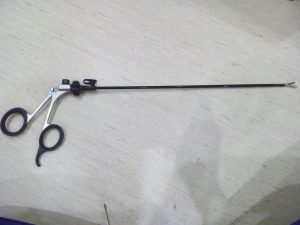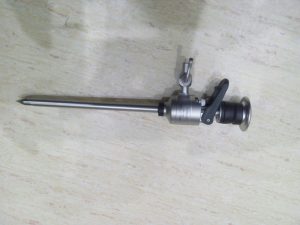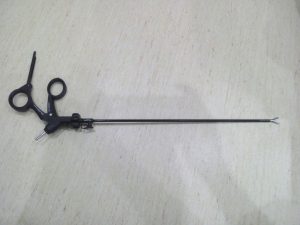Laparoscopy Surgical Instruments listed in the following topics, Laparoscopy surgery mainly operated in the abdomen for diagnostic and surgical correction/repair. Laparoscopy surgery instrument names like trocar and other instrument
The Laparoscopy surgery
Minimally Invasive Surgery based on reducing the mortality and blood loss to the patient. For young patient don’t prefer open surgery due to scar
The MIS prefer the Less infection rate and tissue damage
Laparoscopy surgery Instruments
The Two type of grasping forceps traumatic or atraumatic forceps. 1 usually uses the 5-mm atraumatic grasping forceps and a Babcock clamp.
For secure grasping, 5-mm grasping forceps with 2 X 2 teeth can be used. A 10-mm claw forceps is useful for specimen removal (ovarian cyst, ovary, myoma, etc.) via a 12-mm secondary trocar. Due to its powerful and sharp jaws, this force. must only be applied to the tissue to be removed.
SCISSORS combination of cutting and coagulating can be obtained by incorporating electrical energy
Cold instruments including scissors remain into the scissors. An example is the unipolar the best tools for dissection in reproductive Metzenbaum scissors. Because scissors tend surgery.
A wide variety of scissors are avail to become dull, frequent sharpening is nestable. The most commonly used scissors are scary. Other types of scissors including hook shown in.
It’s important to have scissors and micro dissecting scissors
Scissors that cut and do not tear the tissue.
Suture and ligature
Needle holder and suture holding forceps for skin and for a curved needle with J type should be available. The uses of knot Pusher allows extracorporeal tying and facilitates the procedure. I find that the use of a non-disposable knot Pusher with fenestration at the end markedly expedites the process of knot tying.
After suturing, the needle extracted outside the abdominal cavity and inserted into the fenestration. The surgeon makes a knot and the knot, then pushed into the abdominal cavity. Other types of knot pusher that do not have a fenestration require the surgeon to place the suture in the groove of the knot pusher.
This takes time, especially in a darkened operating theatre.
The availability of a pretied ligature–Endoloops can permit as of structures including appendix, tube or ovary.
Miscellaneous
Administration of a dilute solution of vasopressin decreases bleeding from the site of tubal anastomosis, ectopic pregnancy or myomectomy. In this scenario, special forceps used to inject the injection.
A spinal needle used, but not rigid and bends easily. A nondisposable injection needle (shaft diameter of 5 mm) insert via a secondary trocar. Stabilizing a myoma during dissection and enucleation can be accomplished using a 5mm corkscrew.
Occasionally, a morcellator is needed to break large specimens such as myoma into small pieces and to remove them. A Clip and staple applicator may be needed, although they are not essential.
LASER
LASER, electrocautery or regular scissors are merely surgical modalities. The clinical results depend more on the surgeon’s experience and preference and proper patient selection than the type of surgical modality used.
The use of a laser via a built-in channel of the laparoscope liberates one of the secondary trocars which can be replaced by another ancillary instrument.
DISPOSABLE INSTRUMENTS
There are many disposable instruments available. For economical reasons, I use mainly non-disposable instruments; disposable instruments are utilized when necessary. However, it is recommended to have some disposable instruments in the operating theatre as a back-up.
TROCARS AND REDUCER
Two trocars of 10 mm diameter and two or three trocars of 5 mm should be available. The secondary trocars are usually 5 mm, but one of them should be 12 mm if removal of a specimen is anticipated.
Here, a reduction sleeve (reducer) with 5 mm diameter is necessary.
An ultrashort reduction sleeve (37.5 mm length) is also available. The length of the trocar is usually 105 mm. Depending upon the abdominal thickness, shorter trocars
Reduction sleeve and short trocars with spiral threads. (50 mm) that allow freer access to the pelvic structures can be used. Some trocars have spiral threads on the outside.
The threads prevent slippage of the trocar during removal of ancillary instruments namely forceps or scissors. It is desirable to have secondary trocars without valves. The valves interfere with insertion and removal of ancillary instruments, specimen or suture materials.
Non-disposable trocars are more economical, but their sharpness should be maintained; otherwise, disposable trocars should be used. Blunt trocar used for open laparoscopy
Laparoscopy surgery Basic Instruments names
This is a list of the basic laparoscopy instrument names. Back-up instruments are desirable.
- A 10-min straightforward laparoscope 0°. 2. Trocars
(a) 10-mm primary trocar, (b) 12-mm secondary trocar,
(c) 5-mm secondary trocars (at least three).
Reduction sleeve and short trocars with spiral threads.
Telescope with a different view of the degree
Microforceps
Suction irrigator

Atraumatic grasping forceps
Toothed grasping forceps
Claw forceps
Hook scissor
Metzenbaum scissors
Microdissecting scissors
Suture manipulator or knot Pusher
Needle holder
10 mm trocar
12 mm trocar
5 mm trocar
0-degree telescope
5 mm reduction sleeve
Suction irrigation system
grasping forceps- Bipolar
Unipolar instruments
Unipolar scissor
1mm needle electrode
Forceps
SEMM atraumatic grasping forceps
5mm grasping forceps with 2*2 teeth
10mm claw forceps
Hook scissors
Microdissecting scissors
Needle holder
Suture manipulator or knot Pusher
Needle holder for a curved needle
5mm injection needle
Myoma corkscrew
Morcellator
Laparoscopy instruments
Allis tissue holding forceps used to hold the harder tissue
Also used to hold the specimen during dissection
Hook scissor cutting the thick tissue for dissection
Metzenbaum scissor used for dissection and cutting the structure
Bowl grasper
Atraumatic instruments used in retracting and manipulation of bowl
Monopolar hook
Used during dissection with cut and coagulation setting
Bipolar forceps
Used for controlling bleeder with coagulation of vessels while dissection
Biopsy forceps
Used to remove the specimen from the abdomen without slipping
Maryland forceps
Blunt dissection and retraction of tissue
Suction cannula
Controlled suction for aspiration of the fluids from a cyst
Aspiration needle
Aspiration of fluid from the cysts by making the puncture
Alligator grasper used for grasping tissue and dissection